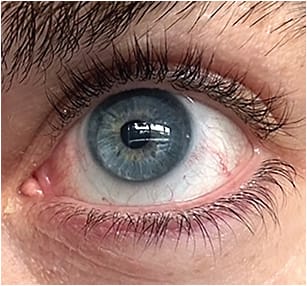For the treatment of ocular surface disease
Ocular surface disease (OSD) can be a contraindication to everyday “traditional” contact lens (CL) wear. Thus, while several OTC, prescription, and in-office treatments are available to treat OSD, using a CL to treat the condition would not necessarily be top of mind for optometrists. This month’s column serves as a reminder that scleral CLs can be an effective treatment for OSD patients.
My most recent referral from a local corneal specialist is a prime example: After fitting this 75-year-old woman, who developed moderate bilateral neurotrophic keratitis (NK) with a secondary blepharospasm and ptosis, she achieved a full recovery and excellent vision with continued daytime wear.
Here, I review OSD and discuss the role of scleral CLs in treating OSD.
Reviewing OSD
OSD, which affects individuals of all ages, is characterized by damage to the epithelium of the cornea and/or conjunctiva. This damage may result from a wide range of causes, including, but not limited to, medications (e.g., anti-depressants), trauma, autoimmune disorders (e.g., rheumatoid arthritis), NK, and aging. Systemic conditions, such as chronic graft-versus-host disease and Sjögren’s syndrome and Stevens-Johnson syndrome, which affect the anatomy and physiology of the lids, lid margins, and tear film, may likewise lead to pathologic changes in the ocular surface.
In mild cases, OSD causes photophobia, pain, and intermittent visual blur. As the condition worsens, patients may experience a limited ability to perform daily activities, poor general health and, in many cases, depression.1
Dry eye disease (DED) is the most encountered form of OSD, with an estimated minimum of 16 million Americans suffering from the condition.2 DED may arise from one or a combination of the following: aqueous deficiency, blepharitis/meibomian gland dysfunction, goblet cell/mucin deficiency, corneal exposure, corneal toxicity, and environmental factors, such as proximity to heat or air ducts, which can cause ocular dryness.

Scleral CL role
Because scleral CLs have large diameters, a fluid reservoir, and rigid optical surfaces, they can be used in moderate-to-advanced OSD cases. Specifically, these are cases in which primary (e.g., topical lubrication, nutritional, and environmental) approaches and secondary supportive and therapeutic measures (e.g., soft bandage CLs, punctal occlusion, topical anti-inflammatory agents) do not provide adequate symptom relief or ocular surface protection.
By maintaining a constant fluid “bath” comprised of un-preserved saline, in addition to optional additives, such as autologous serum or unpreserved artificial tears, the post-scleral CL environment provides corneal lubrication protection from environmental irritants. In fact, studies show scleral CLs improve both the signs and symptoms of corneal punctate staining, filamentary keratitis, and neuropathic pain.3,4
Something else to keep in mind: An online survey of international scleral CL-prescribing trends across multiple practice types reveals that OSD is the second most common indication for prescribing scleral CLs.5
Of course, in treating OSD, scleral CLs are only as good as their fit. Thus, we must:
- Perform a careful pre-fitting evaluation with thorough documentation. This means documenting the presence of scars, neovascularization, corneal haze, and palpebral conjunctival appearance.
- Be mindful of the early identification of corneal changes and/or other adverse events, such as increased corneal staining or stromal or endothelial changes, and whether the changes are independent of or related to CL wear. These are changes often related to the underlying condition but may be exacerbated by CL wear.
- Be aware that adjunctive therapies, such as autologous serum, and topical ocular medications, often are necessary for these patients.
- Follow up. I typically recall my therapeutic scleral CL wearers every three to four months because this time frame allows me to detect any corneal health changes in a timely fashion, and proactively adjust the fit or the wearing schedule.
- Have a mutually supportive interprofessional relationship with an ophthalmological subspecialist to ensure the best outcomes and ongoing care of patients. This would include the possible need for surgical intervention or adjustment of any medications. OM
References
- Craig JP, Nelson JD, Azar DT, et al. TFOS DEWS II Report Executive Summary. Ocul Surf. 2017;15(4):802-812. doi: 10.1016/j.jtos.2017.08.003.
- Farrand KF, Fridman M, Stillman IÖ, Schaumberg DA. Prevalence of Diagnosed Dry Eye Disease in the United States Among Adults Aged 18 Years and Older. Am J Ophthalmol. 2017;182:90-98. doi: 10.1016/j.ajo.2017.06.033.
- Bhattacharya P, Mahadevan R. Case Report: Post-keratoplasty Filamentary Keratitis Managed with Scleral Lens. Optom Vis Sci. 2018;95(8):682-686. doi: 10.1097/OPX.0000000000001252.
- Lim, Li Lim EWL. Therapeutic Contact Lenses in the Treatment of Corneal and Ocular Surface Diseases—A Review. Asia Pac J Ophthalmol. 2020;9(6):524-532. doi: 10.1097/APO.0000000000000331.
- Harthan J, Nau CB, Barr J, et al. Scleral Lens Prescription and Management Practices: The SCOPE Study. Eye Contact Lens. 2018 Sep;44 Suppl 1:S228-S232. doi: 10.1097/ICL.0000000000000387.




